An In-depth Look at John Deere Bean Planters
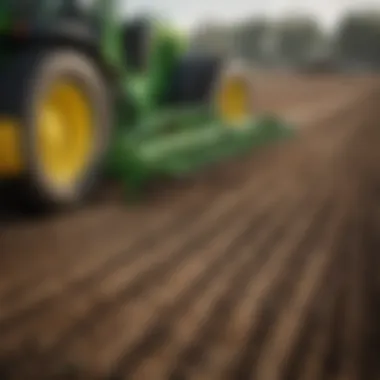
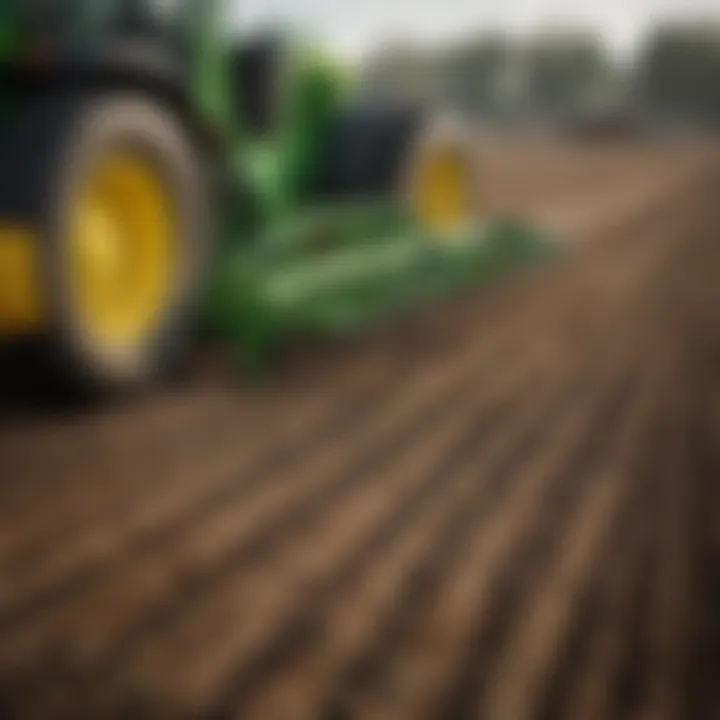
Intro
John Deere bean planters represent a significant advancement in the agricultural sector, particularly in the realm of crop production. For farmers, these machines play an invaluable role in ensuring efficiency, precision, and sustainability. The innovation behind John Deere's designs not only enhances the planting process but contributes positively to the overall farming ecosystem. As we delve further into this examination, the following sections will provide insights into their design features, performance metrics, and maintenance considerations, all while comparing them to other brands in the market.
In this fast-paced agricultural world, staying informed about the tools that can optimize growth and production is crucial. This article aims to arm farmers and agriculture enthusiasts with the knowledge they need to make thoughtful decisions about their equipment, highlighting the unique qualities that set John Deere bean planters apart.
Topic Overview
Definition and Importance
Bean planters are specialized agricultural machines designed to sow seeds in the ground at consistent intervals and depths. The importance of these machines cannot be overstated; they save time, labor, and ensure an even distribution of seeds which leads to better crop yields. John Deere bean planters, in particular, are known for their robust construction and advanced features, making them a favorite among farmers worldwide.
Brief History and Evolution
The journey of bean planters began in the 19th century when farmers relied largely on manual methods. Over the decades, the evolution of mechanization sparked a wave of innovations. John Deere played a pivotal role in this transition through the introduction of the first commercially successful steel plow in 1837, which paved the way for more advanced farming equipment. The subsequent decades saw the emergence of various planting technologies designed to improve speed and efficiency. Today, John Deere bean planters stand at the forefront, equipped with features aimed to cater to modern farming needs.
Key Techniques and Innovations
Sustainable Farming Practices
Sustainability in agriculture is increasingly gaining traction, with many farmers looking to implement practices that protect the environment while maximizing production. John Deere bean planters are designed to minimize soil disturbance and maintain soil health, contributing to the long-term viability of farmland. These machines support crop rotation and cover cropping, making soil more resilient against erosion and nutrient depletion.
Advanced Agronomic Technologies
Advancements in agronomy have led to the integration of technology into farming equipment. John Deere bean planters incorporate precision agriculture technologies that utilize GPS and computer systems to optimize planting operations. This technology allows farmers to
- Monitor soil conditions
- Adjust seed rates automatically
- Gather data for better decision-making
With technology evolving rapidly, John Deere has positioned itself as a leader in implementing these innovations within their bean planters, combining traditional farming techniques with cutting-edge tools.
Practical Applications
Step-by-Step Guides
Using a John Deere bean planter can be straightforward with the right knowledge. Here’s a typical approach to operating these machines:
- Prepare the field. Ensure the soil is ready for planting by testing and treating it as needed.
- Set your planter. Adjust the depth and spacing settings based on seed type and soil condition.
- Load the seeds. Make sure that the machine is loaded correctly for optimal performance.
- Start planting. Engage the machine, maintain a steady pace, and monitor the planting process.
- Post-planting care. Regularly check the planter for any blockages or malfunctions while performing maintenance tasks as recommended.
Case Studies or Real-World Examples
One farmer from Kansas reported a 20% increase in yield after switching to John Deere’s latest model of bean planters. By adopting precision planting techniques, he was able to better manage seed placement and depth, resulting in stronger plants. His success story highlights the tangible benefits of investing in quality equipment.
Overall, it’s clear that John Deere bean planters offer immense value, combining thoughtful design with advanced tech to address today’s agricultural challenges. Their significance not only lies in their functional capabilities but in their contribution to sustainable farming and enhancing overall productivity.
Preamble to John Deere Bean Planters
John Deere bean planters are more than just pieces of machinery; they're pivotal to modern agriculture. For farmers looking to maximize efficiency and productivity, understanding these planters is crucial. Proper seed placement, frame stability, and the integration of technology are all critical components that make these machines the backbone of efficient farming practices. As farmers try to adapt to changing climates and market demands, embracing such advanced equipment becomes not just a choice but a necessity.
Historical Background
The legacy of John Deere kicks off in 1837, when a blacksmith named John Deere created a steel plow that revolutionized farming in the United States. This initial innovation laid the groundwork for what became a leading manufacturer in agricultural machinery. Over the years, the company evolved, responding to the pressing needs of its users.
The bean planter, specifically, has roots that trace back to an era when mechanization started changing the game for farmers across America. By the late 1920s, John Deere had introduced more specialized models, tailored to various crops, including beans, corn, and wheat. The introduction of adjustable seed hoppers and furrow openers improved planting accuracy, ensuring that seeds were placed at optimal depths and spacing.
This historical context highlights how John Deere has consistently prioritized innovation. Keeping an eye on the farmer's realities paved the way for advancements that are now the standard across the board. Today’s models incorporate advanced technology, making them indispensable tools in a farmer's arsenal.
Overview of John Deere's Legacy
John Deere's legacy isn't just about machinery; it embodies a commitment to quality and sustainability that resonates through generations of farmers. The company has built a reputation that many other brands aspire to achieve. As a pioneer in agricultural practices, John Deere focused on not only meeting the demands of the market but also ensuring that its products could withstand the test of time.
This dedication to durability is seen in their bean planters. Farmers have long praised how John Deere equipment often outlasts competitors, minimizing downtime during critical planting seasons.
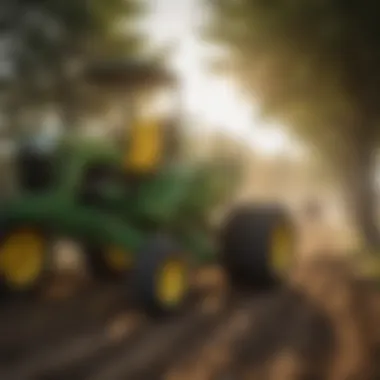

Furthermore, John Deere has made significant strides in integrating sustainable practices into its operations. From reducing soil disturbance to enhancing resource efficiency, the brand has played a vital role in shaping environmentally responsible farming techniques. Many farmers acknowledge that choosing John Deere bean planters isn't just about performance; it's about aligning with a company that embodies their values of land stewardship and forward-thinking.
"Investing in John Deere means investing in the future of agriculture."
With this foundation, the following sections of this article will delve deeply into the design features, operational efficiency, and user experiences associated with John Deere bean planters.
Design and Features
The design and features of John Deere bean planters are crucial elements that set them apart from the competition. They are not just about aesthetics; rather, they encapsulate years of engineering innovation aimed at maximizing efficiency in bean planting. When farmers choose a planter, they don’t only consider how it looks; they evaluate how it can affect their yields and how easy it is to operate. Every feature is designed to simplify tasks, enhance performance, and ensure the longevity of the equipment. Let’s dive into the specifics that make these machines an integral part of modern agriculture.
Frame Structure
The frame structure of a John Deere bean planter is robust and engineered to withstand the rigors of fieldwork. These planters often feature a heavy-duty frame constructed from high-tensile steel, which provides exceptional strength while keeping the overall weight manageable. This ensures stability during operation, particularly on uneven terrain.
The frame's design also influences its adaptability—many models are built with the flexibility to take on multiple configurations, allowing for modifications based on crop type or planting strategies. This adaptability is key, especially for farmers who may want to plant different bean varieties or manage varying field conditions.
Seed Placement Technology
Seed placement technology is arguably one of the most revolutionary aspects of John Deere bean planters. The incorporation of electronic and mechanical components ensures that seeds are deposited at the optimal depth and spacing without fail. This precision minimizes seed wastage and promotes even growth, leading to better crop yield overall.
Moreover, advanced monitoring systems provide real-time data, giving operators immediate feedback on seed placement. This enables farmers to make necessary adjustments on the fly, optimizing their planting strategy like never before. The technology behind seed placement not only supports efficiency but also aligns with the principles of precision agriculture, steering farmers towards more sustainable practices.
Row Spacing Options
Another notable feature is the row spacing options available with John Deere planters. Depending on the model, these planters can accommodate a variety of row widths suitable for different farming techniques and local conditions. Whether a farmer prefers narrow row planting for increased yield per acre or wide rows for better machine access and airflow, there’s a configuration that meets their needs.
This versatility in row spacing also has implications for how farmers manage their plots. It can be adapted not just for beans but for other crops as well, making the investment more valuable over time. Choosing the right row spacing can significantly impact crop health and harvest efficiency, proving just how vital this feature is.
Adjustable Components
The adjustable components of the John Deere bean planters enhance usability and functionality, making life easier for farm operators. Features like adjustable down-pressure settings and row unit height allow users to fine-tune the equipment based on specific field conditions. For example, in heavier soils, more down-pressure might be necessary to maintain uniform seed depth, while lighter soils may require less.
Additionally, many models come equipped with easily adjustable settings for seed population. This feature allows farmers to switch between different planting densities in mere moments, tailoring their approach to suit market demand or environmental conditions. Such flexibility is invaluable in today’s fast-paced agricultural landscape, ensuring that farmers can respond to changing circumstances efficiently.
Ultimately, the design and features of John Deere bean planters are meticulously thought through, catering to the evolving needs of agriculture. By blending sturdy construction with cutting-edge technology and user-friendly adjustments, these machines stand out as formidable allies for bean farmers.
"A planter isn’t just a machine; it’s a farmer’s partner in overcoming the challenges of modern crop production."
By examining each aspect from frame structure to seed placement technology, farmers can appreciate the thoughtfulness that John Deere imbues into its bean planters, leading to greater operational success.
Operational Efficiency
In the context of modern agriculture, operational efficiency plays a pivotal role in determining the success and productivity of farming equipment, particularly bean planters. For farmers, achieving high efficiency means maximizing their crop output while minimizing the input resource, be it fuel, labor, or time. John Deere bean planters are specifically designed with these efficiency principles in mind, making them an essential choice for many agricultural operations. The integration of innovative technologies and user-friendly features leads to significant advantages across various farming scenarios, allowing operators to achieve their goals with ease.
Integration with Tractors
The symbiotic relationship between John Deere bean planters and tractors is essential for enhancing operational performance. These planters are engineered to seamlessly attach to a range of tractors, ensuring a dependable workflow. The compatibility allows farmers to choose the best tractors from their fleet without needing specialized machinery. This integration is not just about mechanical fit; it also involves electronic coordination that facilitates data exchange between the machines. For instance, advanced sensors in the planter can communicate with the tractor to adjust speed and planting depth automatically, creating a synchronized planting process that ensures even seed distribution. This results in better crop establishment, which is crucial for optimizing yields.
Field Coverage and Speed
Efficiency in field coverage is a game-changer in modern farming, especially when time is of the essence during planting seasons. John Deere bean planters help facilitate this by offering versatile row spacing options, enabling operators to navigate fields more effectively. High-speed planting capabilities are another hallmark feature of these machines, allowing farmers to cover more ground in less time without compromising the quality of operation. The well-optimized design reduces soil compaction as well, which further creates a conducive environment for seed germination. Thus, the ability to plant quickly while maintaining optimal conditions is a winning combination that enhances the productivity of farming operations.
Ease of Use for Operators
User-friendliness is often overlooked but is critical for operational efficiency. John Deere makes strides in ensuring their bean planters are intuitive and straightforward to operate. The layout of control systems is designed for logic and ease of access, minimizing the learning curve for new operators. Features like color-coded settings and digital displays not only simplify decision-making but also enhance real-time monitoring, allowing farmers to make informed adjustments while working in the field. Moreover, the ergonomic design of the operator's station ensures comfort during long hours of operation. When operators can handle their equipment smoothly and efficiently, errors are reduced, resulting in better overall field performance.
"Better operational efficiency leads to higher yields and reduced costs, an equation that no modern farmer can afford to ignore."
By focusing on these critical areas—tractors integration, field coverage capabilities, and operator ease—John Deere bean planters exemplify the principles of operational efficiency. This makes them not only a choice but a strategic investment for farmers aiming for success in an increasingly competitive agricultural landscape.
Technological Innovations
Technological innovations play a pivotal role in enhancing the capabilities of John Deere bean planters. As agricultural practices evolve, it's crucial for equipment to keep pace with the demands of modern farming. These innovations lead to increased efficiency, improved accuracy in planting, and better resource management, all which contribute to healthier crops and greater yields. The integration of advanced technology not only caters to the operational needs of farmers but also addresses environmental concerns, ensuring a more sustainable approach to agriculture.
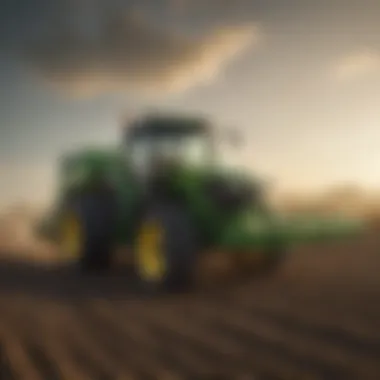

Precision Agriculture and Data Management
Precision agriculture has transformed the way farmers approach planting and crop management. John Deere's bean planters utilize state-of-the-art GPS technology combined with real-time data analytics. This system enables farmers to collect and analyze extensive data about soil conditions, moisture levels, and plant health.
- Benefits of Precision Agriculture:
- Increased Yield: By optimizing seed placement based on the specific condition of the soil, farmers can maximize their yield potential.
- Resource Management: Water and fertilizer can be applied more efficiently, which reduces waste and can save money in the long term.
- Data-Driven Decisions: With accurate data, farmers can make well-informed decisions that lead to higher efficiency.
An example of this is the implementation of John Deere's Operations Center. This cloud-based platform provides farmers an overview of their fields and equipment, analyzing various data points. Farmers are able to adjust their techniques based on what gives the best results, making each planting season markedly more effective than the last.
"The adoption of precision agriculture equips farmers with the tools to not just grow more but to grow smarter."
Automation and Robotics Integration
The integration of automation and robotics in John Deere bean planters has redefined traditional farming. Automation minimizes human error and allows for consistent, precise planting, which is essential for maximizing productivity. This technology facilitates everything from seed planting to data collection without constant human oversight.
- Key Aspects of Automation:
- Enhanced Efficiency: Automating repetitive tasks allows farmers to focus on strategic decisions and overall farm management.
- Reduced Labor Costs: With robots handling the bulk of the operation, costs associated with manpower can decrease significantly.
- Consistency: Automated systems ensure that every seed is planted at the intended depth and spacing, which can improve germination and growth rates.
Moreover, John Deere is advancing its robotics technologies, which can perform tasks autonomously. This not only streamlines operations but also enhances safety by reducing the need for manual interventions in potentially hazardous conditions. As these technologies continue to evolve, farmers will likely see a reliance on automated solutions only grow, ushering in a new era of smart farming.
Maintenance and Care
Maintaining John Deere bean planters is a critical and often underappreciated aspect of maximizing their performance and longevity. Regular upkeep not only ensures that the machine operates at its best but also helps prevent unexpected breakdowns that could lead to costly repairs or, worse yet, hindered field work during planting season. For farmers relying on these machines, embracing a routine of maintenance is akin to tending to their crops; it's about nurturing the tools that, in turn, nurture the land.
Regular Maintenance Schedules
Setting a consistent maintenance schedule for bean planters is paramount. Routine checks can spell the difference between a smooth planting season and a disaster. Here are key elements to incorporate:
- Daily Inspections: Before each use, inspect critical components such as seed hoppers, furrow openers, and row units to ensure everything is in working order.
- Weekly Lubrication: Greasing moving parts weekly can prevent wear and tear, ensuring your machine runs like a top.
- Seasonal Overhaul: At the end of each planting season, it’s advisable to do a thorough check. This includes cleaning, checking wear parts, and addressing any discrepancies that may have arisen during the season.
By adhering to these schedules, operators can avoid many common issues associated with neglected maintenance.
Common Issues and Troubleshooting
Despite diligent maintenance, issues can crop up. Understanding common problems with John Deere bean planters allows operators to troubleshoot effectively. Here are a few common woes:
- Uneven Seed Placement: This can often be remedied by re-adjusting the seed plates or ensuring that the seed hopper is adequately filled.
- Clogged Furrow Openers: Soil, debris, or leftover residue can clog these components. Regular cleaning after use can help prevent this annoyance.
- Hydraulic System Malfunctions: Leaks or inconsistent pressure can appear over time. Operators should routinely check all hydraulic connections and levels.
Beyond fixing these issues, understanding their root causes can lead to implementing better practices in care and maintenance. As farmers explore solutions, it might be wise to consult resources like Wikipedia or even farmer forums on Reddit.
"A well-maintained planter is like a well-tuned engine; it works efficiently and delivers the results expected at harvest time."
Sustainability Considerations
As the world grapples with the growing impact of climate change and the depletion of natural resources, the agricultural sector is stepping up to the plate with sustainable practices. John Deere bean planters are not only seen as tools for planting but as vital components in the quest for sustainable farming. Understanding the sustainability considerations surrounding these machines can help farmers appreciate how they can limit their environmental footprint while maximizing yields.
Reduction of Soil Disturbance
In traditional farming, tillage has been a standard practice, often leading to significant soil disruption. John Deere bean planters have been designed with minimal till technology that reduces soil disturbance substantially. This means the soil structure remains intact, preserving its organic matter and microbial life. The health of the soil is crucial for growing crops, and when the soil isn't overturned frequently, it retains moisture better, reduces erosion, and promotes nutrient cycling.
Notably, less disturbance helps in sequestering carbon in the soil, turning bean planting into an ally against greenhouse gas emissions. Furthermore, with strategies like no-till or strip-till integrated into the planter's design, there's a dual benefit—farmers can boost their yields while participating in environmentally viable farming practices. Farmers following these practices often report better crop resilience and resource utilization.
Resource Efficiency
Resource efficiency is another cornerstone of sustainable agriculture, and John Deere bean planters excel in this area. By optimizing seed placement based on local conditions, these machines ensure that seeds are planted at the right depth and density, enhancing germination rates without wasting resources. This precision leads to less seed requirement and ultimately translates to reduced costs for farmers.
Moreover, these planters are designed for fuel efficiency, which is paramount in reducing the carbon footprint during operations. The integration of GPS-guided technology allows these machines to operate within narrower margins, ensuring field coverage is maximized without unnecessary fuel expenditure. Thus, farmers can cultivate their fields more effectively while saving on fuel costs and decreasing overall emissions.
- Advantages of Resource Efficiency:
- Decreased seed costs due to optimized planting.
- Less fuel consumption during field operations.
- Better crop yields resulting from precise resource utilization.
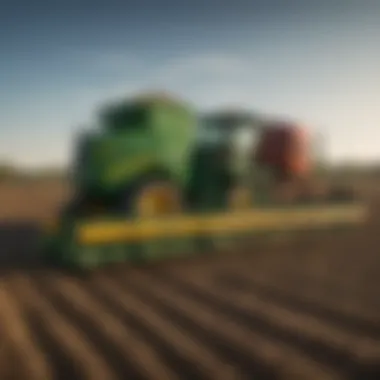

Emphasizing sustainability in agriculture isn’t just a trend; it’s a necessary evolution. With John Deere bean planters, farmers are not only enhancing efficiency but are also embracing a more sustainable approach to farming. As stewards of the land, incorporating eco-friendly practices using advanced technology will benefit both the producers and the planet, securing a healthier future for generations to come.
"Sustainable farming practices are no longer an option; they are essential for preserving the delicate balance of our ecosystem and ensuring food security worldwide."
The advancements found in John Deere's bean planters are clear indicators of how the agricultural industry is pivoting, ensuring that while we're feeding the world, we are also protecting it.
Comparative Analysis with Other Brands
When evaluating John Deere bean planters, it becomes crucial to compare their features and performance against competitors. This comparative analysis isn’t just for market enthusiasts; it helps farmers make sound investment decisions tailored to their unique operational needs.
Market Positioning and Brand Reputation
John Deere has carved a significant niche in the agricultural machinery market, known for its reliability and cutting-edge technology. The company leverages its long-standing history to build trust among users, which is evident in its marketing strategies. For instance, the green and yellow color scheme is not just a branding gimmick; it symbolizes the commitment to quality and performance.
In comparison, brands like Case IH, AGCO, and Kinze also vie for a piece of the market. However, John Deere’s reputation often outweighs that of its competitors, primarily due to its robust customer support and a vast dealership network. A farmer considering a new planter might hear comments like "I’ve always trusted John Deere to do the job right," signaling the weight of brand loyalty.
When discussing reputation, it’s also vital to look at consumer reviews and testimonials. Many users on platforms like Reddit praise the durability of John Deere equipment, while critiques of other brands often mention issues with parts availability or service.
Performance Metrics
In the world of bean planting, performance metrics matter. They reflect how well a machine operates under various conditions, and this directly impacts productivity. Here’s where John Deere shines, consistently ranking high in tests against other brands in several areas:
- Seed Placement Precision: Studies show that John Deere planters deploy seeds with remarkable accuracy, reducing waste and promoting uniformity in crop growth. This precision stems from sophisticated technology embedded in their design, which competitors sometimes struggle to match.
- Durability and Longevity: Farmers have reported that John Deere machines last appreciably longer than others. The materials used in production are highly regarded, helping to withstand wear and tear through demanding use seasons.
- Fuel Efficiency: Compared to its rivals, John Deere machinery demonstrates lower fuel consumption, a significant operational cost consideration for large-scale farmers. It’s common to see farmers mention how their John Deere machinery provides more "bang for the buck" with fewer fuel expenses.
- User Friendly Features: The design of John Deere planters often caters to a diverse user base, making them easier to operate and adjust than many other brands. This includes intuitive controls and navigational aids, which is a blessing for those who may not be as technically inclined.
A farming operation’s choice between John Deere and its competitors should hinge on more than price alone. Not all bean planters are created equal; the attributes mentioned shape the ongoing yield of crops, which is the ultimate end goal in agriculture.
"In agricultural equipment, a penny saved today could cost you a fortune later. Choose wisely."
In assessing the full scope of options, it’s always prudent to let metrics guide your choices behind the wheel—after all, in farming, precision counts.
User Experiences and Testimonials
User experiences and testimonials are vital components when discussing John Deere bean planters. They offer a grounded perspective that transcends technical specifications and engineering marvels. Farmers who rely on these machines understand their performance in practical settings, providing insights that can only be gleaned through firsthand use. Delving into real-life accounts can help potential buyers assess the value of these planters and make informed decisions.
Gleaning insights from actual users helps in highlighting not only the benefits but also the challenges faced in the field. Their narratives can illuminate aspects such as easy maintenance, effectiveness in diverse soil types, and resilience under various weather conditions. This isn't just fluff—it's practical wisdom from those who live and breathe agriculture.
Case Studies from Farmers
Consider the experience of a mid-sized corn and bean farmer, who invested in a John Deere 1775NT planter. His operation spans several hundred acres, and the decision to switch to this model stemmed from a need for better precision and efficiency. Over the past few seasons, he found that the planter’s seed placement technology enhanced his yields significantly. With measurements taken directly from his fields, he reported an increase in bean production by nearly 20% compared to previous years, thanks to the accurate planting depth and spacing.
Another farmer, focusing on organic production, shared that he chose the John Deere 1695 planter for its versatility and reduced soil disturbance. His feedback emphasized how this has allowed him to maintain better soil health, critical for long-term sustainability. These case studies resonate with many within the agricultural community, proving that the choice of equipment impacts not only yield but also sustainability.
Feedback on Efficiency and Cost-effectiveness
When discussing efficiency and cost-effectiveness, many farmers emphasize how John Deere bean planters consistently outperform competitors in various metrics. One long-time user highlighted that, while the initial investment may seem steep, the fuel savings and reduction in labor costs over time create a substantial return on investment.
Farmers have also noted that the ease of use greatly contributes to efficiency. For instance, features like automatic calibration and intuitive control systems streamline the planting process, allowing operators to focus on other essential farm tasks. This efficiency is especially crucial during planting season when time is of the essence.
"The balance of upfront cost and long-term savings is why I stick with John Deere. It’s not just a planter, it's a partner in maximizing my productivity." — A seasoned bean farmer
Future Developments in Bean Planters
Future developments in bean planters are not just an exciting topic; they’re essential for the continual evolution of modern agriculture. As the demands for efficient, sustainable, and high-yield farming methods grow, so does the need for bean planters to adapt and innovate. This section dives into the advancements that are on the horizon and their potential impact on farmers worldwide.
Emerging Technologies
The landscape of farming is changing rapidly due to the rise of emerging technologies. Here are some noteworthy advancements:
- Artificial Intelligence: AI technologies are being built into planter systems to optimize seed distribution and monitor soil conditions. This can lead to personalized planting strategies that cater specifically to the needs of individual parcels of land.
- Remote Sensing: Technologies such as drones and satellite imaging will offer farmers real-time data about soil moistness, crop health, and pest activity. Implementations like these help farmers make quicker, smarter decisions.
- IoT Integration: Internet of Things devices can now be embedded into each planter. This gives farmers a live feed on machine performance, soil conditions, and even the weather forecast, ensuring that everything functions at peak efficiency.
The synergy between traditional practices and these new technologies is expected to not only enhance efficiency but also reduce wastage, making farming more environmentally friendly and cost-effective.
Predicted Trends in Design and Functionality
As farming techniques evolve, so too does the design and functionality of bean planters. Here are a few trends to keep an eye on:
- Modular Designs: Future bean planters may lean towards modular designs that allow for easy upgrades and repairs. Farmers won't need to invest in entirely new machines as advancements are made.
- User-Centric Interfaces: Expect more user-friendly controls and interfaces that boost operator experience. Interactive screens displaying real-time analytics will simplify the operations and allow even novice users to manage complex tasks with ease.
- Sustainable Materials: As the agricultural sector strives for sustainability, manufacturers are likely to start using eco-friendly materials that reduce the carbon footprint of the machines themselves.
In summary, as we look down the road, the future developments in bean planters signal an era of sophistication not seen before. They encapsulate a blend of technological innovation and sustainable practice that aims to meet the challenges of modern farming head-on. The integration of these developments into farming routines will not just ease the burden of labor; it will also yield greater efficiency and productivity that farmers so keenly desire.



